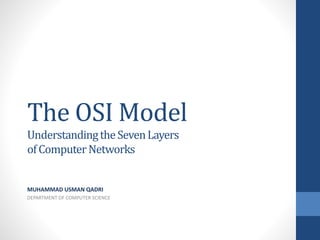
The osi model
- 1. The OSI Model UnderstandingtheSevenLayers ofComputerNetworks MUHAMMAD USMAN QADRI DEPARTMENT OF COMPUTER SCIENCE
- 3. Introduction The Open Systems Interconnection (OSI) model is a reference tool for understanding data communications between any two networked systems. It divides the communications processes into seven layers. Each layer both performs specific functions to support the layers above it and offers services to the layers below it. The three lowest layers focus on passing traffic through the network to an end system. The top four layers come into play in the end system to complete the process.
- 4. An Overview of the OSI Model
- 5. The main benefits of the OSI model include the following: • Helps users understand the big picture of networking • Helps users understand how hardware and software elements function together • Makes troubleshooting easier by separating networks into manageable pieces • Defines terms that networking professionals can use to compare basic functional relationships on different networks • Helps users understand new technologies as they are developed • Aids in interpreting vendor explanations of product functionality
- 6. Layer 1 – The Physical Layer The physical layer of the OSI model defines connector and interface specifications, as well as the medium (cable) requirements. Electrical, mechanical, functional, and procedural specifications are provided for sending a bit stream on a computer network.
- 7. Components of the physical layer include: • Cabling system components • Adapters that connect media to physical interfaces • Connector design and pin assignments • Hub, repeater, and patch panel specifications • Wireless system components • Parallel SCSI (Small Computer System Interface) • Network Interface Card (NIC) In a LAN environment, Category 5e UTP (Unshielded Twisted Pair) cable is generally used for the physical layer for individual device connections. Fiber optic cabling is often used for the physical layer in a vertical or riser backbone link. The IEEE, EIA/TIA, ANSI, and other similar standards bodies developed standards for this layer.
- 8. Layer 2 – The Data Link Layer Layer 2 of the OSI model provides the following functions: • Allows a device to access the network to send and receive messages • Offers a physical address so a device’s data can be sent on the network • Works with a device’s networking software when sending and receiving messages • Provides error-detection capability Common networking
- 9. Components that function at layer 2 include: • Network interface cards • Ethernet and Token Ring switches • Bridges
- 10. Layer 3 – The Network Layer Layer 3, the network layer of the OSI model, provides an end- to-end logical addressing system so that a packet of data can be routed across several layer 2 networks (Ethernet, Token Ring, Frame Relay, etc.). Note that network layer addresses can also be referred to as logical addresses.
- 11. Layer 4 – The Transport Layer Layer 4, the transport layer of the OSI model, offers end- to-end communication between end devices through a network. Depending on the application, the transport layer either offers reliable, connection-oriented or connectionless, best-effort communications.
- 12. Some of the functions offered by the transport layer include: • Application identification • Client-side entity identification • Confirmation that the entire message arrived intact • Segmentation of data for network transport • Control of data flow to prevent memory overruns • Establishment and maintenance of both ends of virtual circuits • Transmission-error detection • Realignment of segmented data in the correct order on the receiving side • Multiplexing or sharing of multiple sessions over a single physical link
- 13. Layer 5 – The Session Layer Layer 5, the session layer, provides various services, including tracking the number of bytes that each end of the session has acknowledged receiving from the other end of the session. This session layer allows applications functioning on devices to establish, manage, and terminate a dialog through a network.
- 14. Session layer functionality includes: Virtual connection between application entities • Synchronization of data flow • Creation of dialog units • Connection parameter negotiations • Partitioning of services into functional groups • Acknowledgements of data received during a session • Retransmission of data if it is not received by a device
- 15. Layer 6 – The Presentation Layer Layer 6, the presentation layer, is responsible for how an application formats the data to be sent out onto the network. The presentation layer basically allows an application to read (or understand) the message.
- 16. Examples of presentation layer functionality include: Encryption and decryption of a message for security • Compression and expansion of a message so that it travels efficiently • Graphics formatting • Content translation • System-specific translation
- 17. Layer 7 – The Application Layer Layer 7, the application layer, provides an interface for the end user operating a device connected to a network. This layer is what the user sees, in terms of loading an application (such as Web browser or e-mail); that is, this application layer is the data the user views while using these applications. Examples of application layer functionality include: • Support for file transfers • Ability to print on a network • Electronic mail • Electronic messaging • Browsing the World Wide Web
